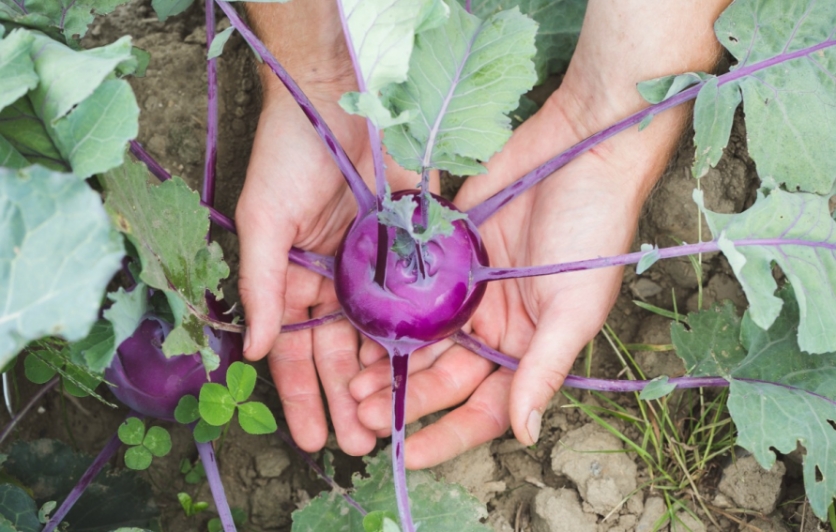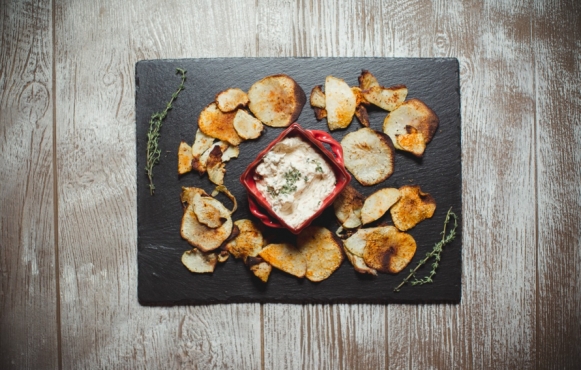Kohlrabi: A Bulb That Brightens Your Menu

While kohlrabi has a following in the United States, its greatest popularity and demand is found in Germany, India and Eastern Europe. The name comes from the German “kohl,” meaning cabbage, and “rabi,” meaning turnip, because the plant’s swollen stem looks very much like a turnip.
While kohlrabi has a following in the United States, its greatest popularity and demand is found in Germany, India and Eastern Europe. The name comes from the German “kohl,” meaning cabbage, and “rabi,” meaning turnip, because the plant’s swollen stem looks very much like a turnip. The truth is that this vegetable is neither of these; it stands on its own merits with a hint of broccoli flavor. Kohlrabi is also known as German turnip, stem turnip, and cabbage turnip. It is a member of the Brassicaceae family, also known as Cruciferae. This group of vegetables includes Brussels sprouts, radishes, horseradish, bok choy, kale, cabbage, broccoli, arugula, rapeseed, cauliflower and turnips.
There are two main varieties of kohlrabi, white and purple, although the interiors of both are a creamy, yellowish color. The kohlrabi family is made up of the white and purple Vienna, white and purple Danube, Grand Duke and Gigante. The Gigante is the only variety that grows to a large size without becoming woody in texture. A good rule of thumb when purchasing kohlrabi is to remember that the larger its size, the woodier the texture will be.
The rounded, swollen stem of the plant grows above ground. This bulb is what you see for sale at your local grocery, food co-op, or farmers’ market. If you are able to find bulbs with their leaves still attached, don’t pass them by; the greens are edible, making them an excellent dietary choice. The greens are delicious sautéed, steamed or eaten raw. There is one variety of kohlrabi that does not have a swollen stem; it consists of only leaves and a thin stem. This type of kohlrabi is called Haakh.
When shopping for kohlrabi, try to find medium bulbs that feel heavy for their size. Look for bulbs that are sphere-like in shape since those that are tapered may be woodier. Avoid bulbs with cracks, cuts, soft spots or brown areas. If the leaves are attached, check to see that they appear fresh and green and show no signs of wilting and mold. You can judge whether a plant is young, or old, by its size. Younger kohlrabi is usually smaller, between two and three inches in diameter. These plants tend to be more tender compared to the older bulbs that are often woodier in texture. Kohlrabi is a cool-weather plant; therefore those harvested in the summer may be woodier than those picked during the cooler months.
Kohlrabi is similar in texture to cabbage hearts or broccoli stems but with a milder, sweeter flavor. When eaten raw the vegetable has a bit of a kick, much like a radish/ turnip combination. When you bite into a slice of raw kohlrabi, it is slightly crunchy. This vegetable is very versatile and can be prepared in a variety of ways. Try it steamed, boiled, pureed or baked. Cut it into quarters then give a toss or two in olive oil, salt and pepper and roast like potatoes. Kohlrabi is a delicious addition to vegetable soup or perhaps your favorite cream soups such as potato or broccoli. Its sweet cabbage and turnip flavor adds zest to many culinary creations.
The growing season for kohlrabi stretches from late spring through late fall. Fortunately, kohlrabi can be frozen for use during the long, cold winter. To do so just peel, slice and blanch it for two to three minutes. Place in an ice water bath to shock, then pat dry and freeze. Now you have kohlrabi at your fingertips for use at any time of the year. The bulbs will keep in your refrigerator’s vegetable bin for several weeks. Remove any attached leaves before storing. When wrapped in a damp paper towel and refrigerated, the leaves will last for up to two to three days. Be sure to wash them thoroughly before using. You can use the leafy greens as you would collards or kale. Boil in salted water for several minutes, or sauté in olive oil with garlic. They can also be eaten raw or in a tossed salad, as can the kohlrabi bulb.
Peeling a kohlrabi bulb may present a challenge to the novice. Some folks like to use a vegetable peeler but find that maneuvering around the plant’s knobby areas, where the leaves were once connected, can be quite a trying task. Others prefer using their favorite paring knife to do the job. See what works best for you. Begin by trimming off the stem end, then removing the skin and any inner areas that may be woody. Remember to peel thoroughly—first, the hard outer skin, then the fibrous layer that lies beneath. This step is very important because the tough fibers do not soften when cooked and are almost impossible to swallow! A good rule to follow when peeling kohlrabi is to “peel once, then peel again!” The goal is to reach the fleshy part of the vegetable. This dual peeling process means that the cook is left with a smaller amount of the fleshy, edible part of the bulb. Be sure to keep this in mind when purchasing your kohlrabi; it is better to buy an extra bulb or two, as you will end up with less food after the peeling process is complete.
Kohlrabi is a great source of vitamin C and contains good amounts of many B-complex vitamins such as niacin, B6, thiamin and pantothenic acid. There are also healthy levels of minerals such as copper, calcium, potassium, manganese, iron and phosphorus. This knobby little vegetable has soared to the top of my list of healthy eating choices because it contains zero cholesterol, little fat and few calories.
Kohlrabi has been around for over a century, and yet here in our own country, it is still a relatively unknown vegetable. Take into consideration that it is both flavorful and versatile while also containing healthy amounts of certain important vitamins and minerals. I, for one, am going to add it to my list of go-to veggies. Count me as the newest member of the Kohlrabi Fan Club!
Tracey Medeiros likes to keep it local and seasonal in her kitchen.





